Delivering sustainable infrastructure through innovation and collaboration
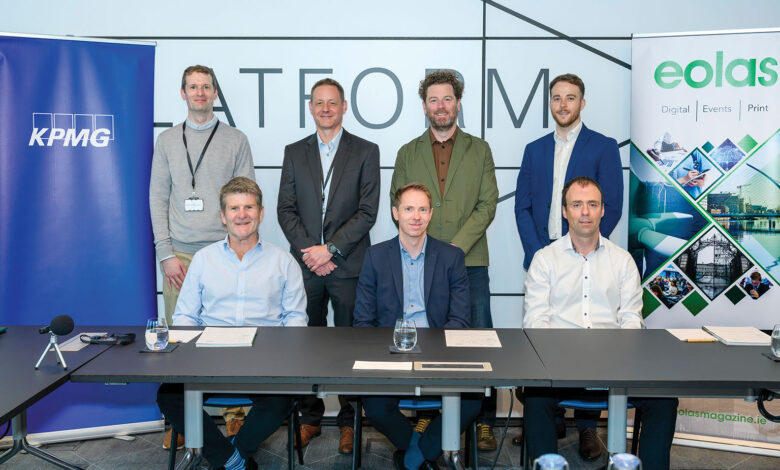
KPMG hosted a round table discussion with key commercial semi-state bodies, industry, and the national research centre for construction technology and innovation to determine how sustainable infrastructure can be delivered through enhanced innovation and collaboration.
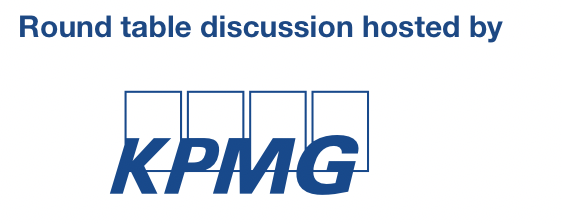
What are the main drivers of a sustainable infrastructure system?
Paul O’Neill
There are two main drivers of a sustainable infrastructure system. Firstly, having joined up thinking when it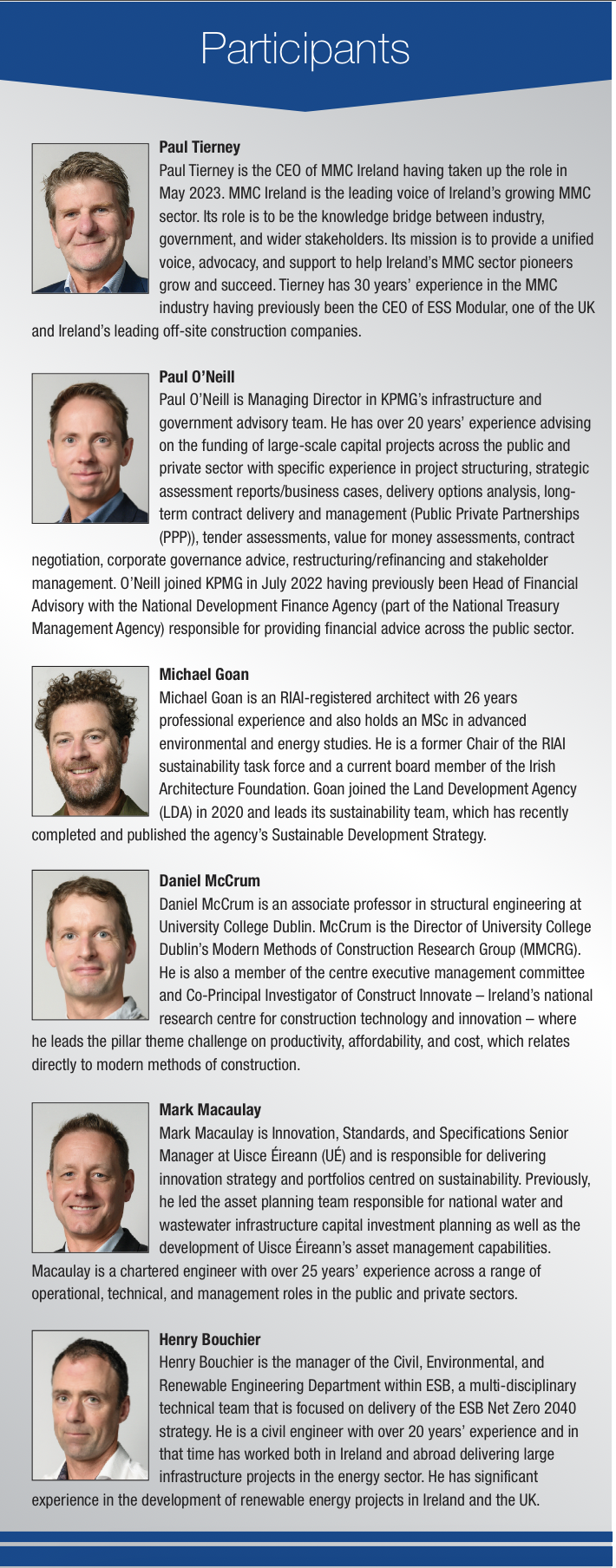 comes to delivering a strategic framework for public capital investment, such as the National Development Plan. However, what I have observed over the years is evidence of siloed thinking. We must step back and ensure collaboration across the board via centralised delivery units. Secondly, we must be conscious of what we need from our sustainable infrastructure; we can sometimes be too inward when we consider sectoral sustainability developments. We need to better describe the wider societal risks of not doing projects which should help lead to more informed decisions between infrastructure delivery and sustainable development.
comes to delivering a strategic framework for public capital investment, such as the National Development Plan. However, what I have observed over the years is evidence of siloed thinking. We must step back and ensure collaboration across the board via centralised delivery units. Secondly, we must be conscious of what we need from our sustainable infrastructure; we can sometimes be too inward when we consider sectoral sustainability developments. We need to better describe the wider societal risks of not doing projects which should help lead to more informed decisions between infrastructure delivery and sustainable development.
Henry Bouchier
Policy is ultimately what will drive a sustainable infrastructure system. Intertwined with that, it requires organisations that show leadership from the top and sustainability must be factored into the decision making to invest in and to proceed with projects. We must be cognisant of the risks of not driving forward sustainable infrastructure. Similarly, strong leadership is key to ensuring that we have all stakeholders engaged. If we can optimise these drivers, we will unlock a pipeline for sustainable infrastructure which can inspire confidence in industry.
Michael Goan
The Land Development Agency’s newly published Sustainable Development Strategy for 2024-2028 works down from the UN Sustainable Development Goals, European policy and legislation, followed by national policy and legislation and how this manifests in local authority development plans and considers how that impacts the LDA from a demand perspective. When tasked with delivery and regeneration projects, social infrastructure is an important aspect of the LDA’s work. We work with colleagues in the energy, transport, housing, and water sectors to strategically plan ongoing projects, as well as medium- to-long-term projects. When it comes to delivering sustainable infrastructure, we must always remember the communities we are serving and ensure that in addition to transport, water, and other physical infrastructure, that the social infrastructure to support sustainable communities is accessible. This includes education, healthcare, employment, sports, and community infrastructure.
Mark Macaulay
Uisce Éireann is delivering sustainable solutions such as integrated constructed wetlands for wastewater treatment. To support this, we require enhanced capability and capacity in our supply chain. Given our dependence on this supply chain for sustainable infrastructure delivery, we need a commitment to long-term funding which will signal to the market that a strong pipeline for sustainable solutions exists. Cooperation with our regulators is also essential to ensure that we have a cohesive approach to sustainability.
Daniel McCrum
Legislation drives sustainable infrastructure delivery, especially given the enhanced importance of a circular economy and our emissions reductions targets. However, one challenge we face is relatively low productivity in the construction sector – despite the economy operating at virtually full employment – given that the cost of the infrastructure we are developing is getting more expensive. Sustainability is an added layer on top of productivity and cost, and we are currently at a stage where large companies are undergoing a process deciding how best to meet all these requirements. As such, some of these factors are not directly about sustainability, but the change that is happening is resulting us needing to have a conversation about the wider context because these are all important variables to consider.
Paul Tierney
There are many factors driving sustainable infrastructure delivery, but the main one is need; we must do this because there is no alternative. Speaking to different stakeholders in this context, it is clear that we need a cohesive plan driven by government. While this is undoubtedly in progress, it is not fully in place right now. In its absence, sustainable infrastructure will not be delivered.
How can government policy best inform the ambition of sustainable infrastructure delivery?
Henry Bouchier
There have been many developments, with government policy leading transformation through green procurement and the transition to a circular economy. Policy is followed by standards, regulations, and licencing, for example, how demolition waste is categorised. We must now align all regulation and licensing relating to sustainable infrastructure development in a cohesive manner. One positive in this regard is that the will to do so is evident, as we saw with Taoiseach Simon Harris’ comments about creating a department of infrastructure. This could be a very positive change for sustainable infrastructure development.
Michael Goan
What is interesting about the Taoiseach’s proposal on a department of infrastructure is that it points to a more centralised approach being seen as necessary for delivery. The new Planning and Development Bill – which, once enacted, will increase the lifespan of development plans from a seven-year to a 10-year cycle – is vital and can support the longer-term planning required to deliver complex development particularly in urban areas and a coordinated approach to delivering the supporting infrastructure. There is a lot more potential for centralised coordination.
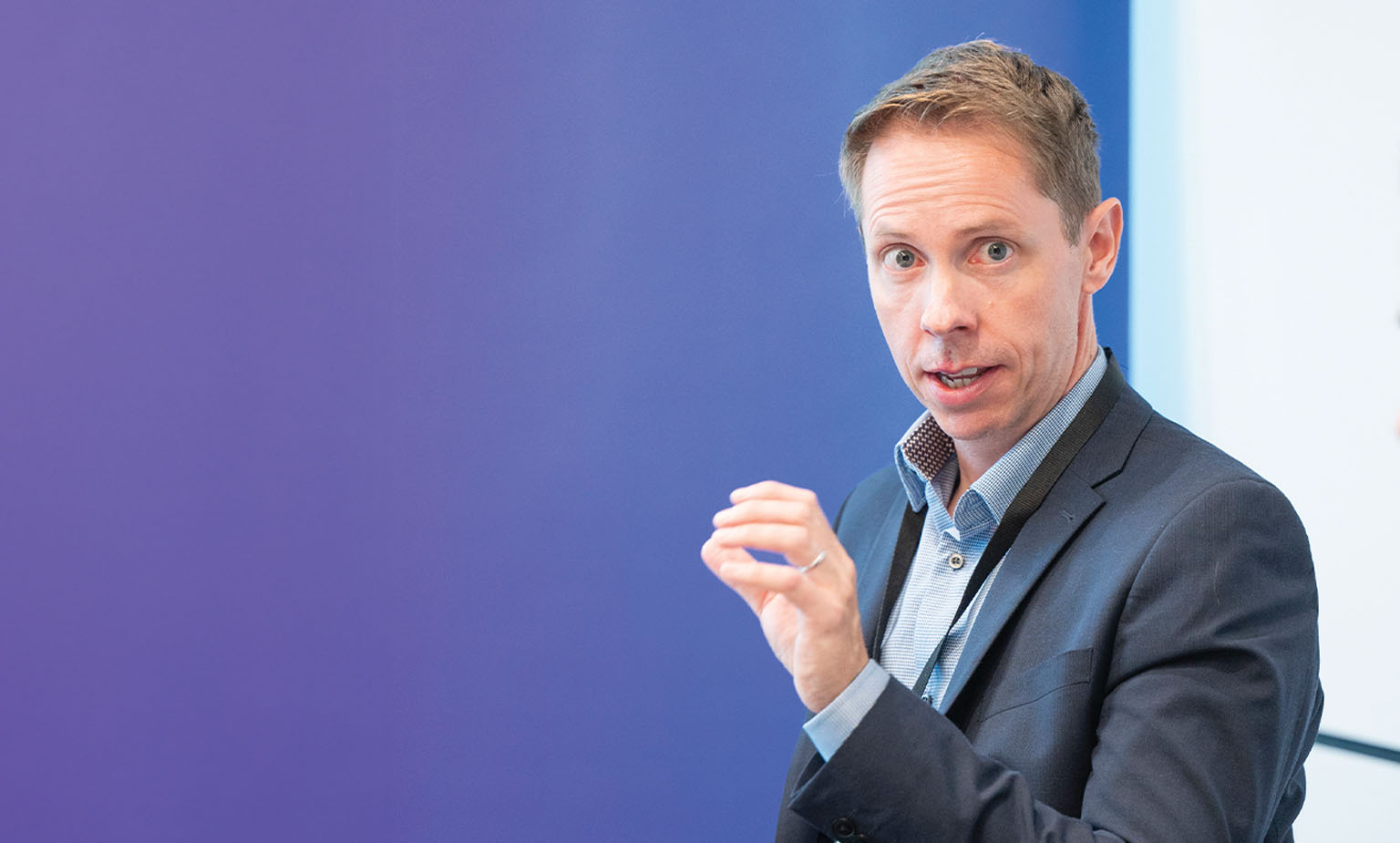
“Where are the political champions of major infrastructure projects?”
Paul O’Neill
Paul O’Neill
Government policy sets the direction of ambition and there has been a shift in emphasis in the importance of getting projects delivered as soon as possible. Multiannual funding is key to delivering this. Whether we need a new department to do this is another question, but until you unlock that clarity and certainty of funding to key delivery partners, it is difficult for these partners to be able to outline long-term deliverables.
Mark Macaulay
Policies have set out what required infrastructure is required. The challenge for all organisations is to figure out their respective courses of action for delivery. However, with range of policies being rolled out, this is a dynamic and complex challenge. Water is at the centre of a lot of policy, whether it is housing, hydrogen, or heat, making this a complex landscape for Uisce Éireann. Early engagement with key stakeholders works well to ensure cross-sectoral alignment over these policy objectives so that we develop our action plans in a coordinated manner.
Daniel McCrum
In 2021, a detailed description of needs for the Irish construction sector was published where the skills challenges and opportunities in the construction sector were analysed and outlined the need for digitalisation of the planning process, a construction technology centre, and digitalisation of the construction sector. This led to the creation of Construct Innovate, Build Digital, etcetera. I think an updated version of this analysis which accounts for new developments since then would be beneficial. While looking at UK policy as an exemplar is a useful exercise, we should also remember that Ireland is a small and flexible nation, and we can innovate beyond what others are doing. Similarly, our challenges are slightly different to those of the UK, and we have the space to be more ambitious.
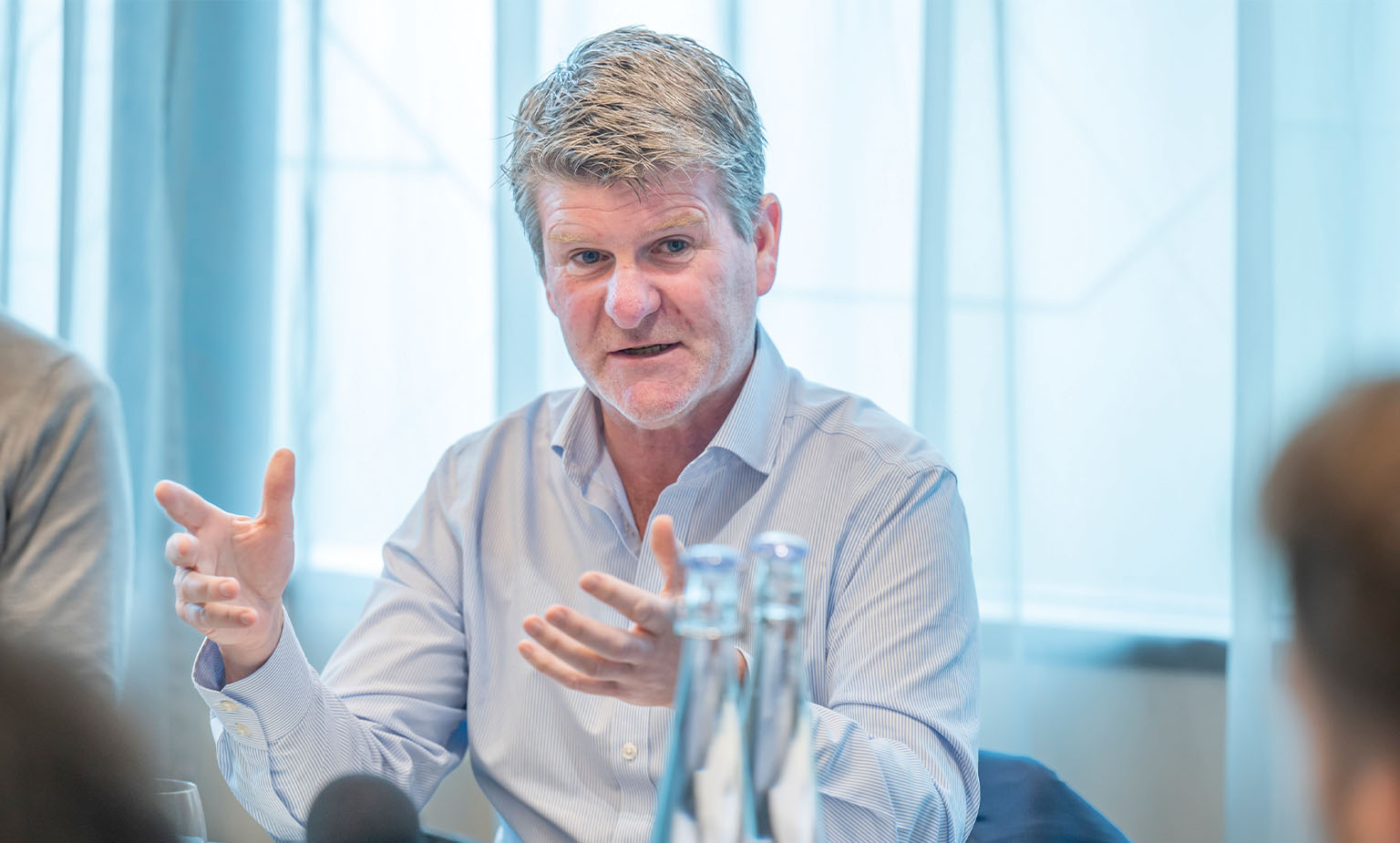
“There are many factors driving sustainable infrastructure delivery, but the main one is need; we must do this because there is no alternative.”
Paul Tierney
Paul Tierney
What we need is a department for joined up thinking, and if that is called a department of infrastructure, that will work. What I have seen is a lack of joined up thinking and this is not because of a lack of willingness, it is because people instinctively operate in siloes. A centralised point of operations for planning infrastructure delivery in transport, education, health, and housing would bridge the existing gap in joined up thinking which is currently inhibiting progress.
What are the most significant barriers to effective innovation and collaboration within the broader infrastructure sector?
Daniel McCrum
Over 91 per cent of those working in the construction sector are employed by SMEs with almost 93 per cent of those working in the construction sector are employed by SMEs with six or fewer employees. That is the reality and there are two primary barriers in this context. Firstly, the ability of these SMEs to invest in innovation is relatively limited. That is where Construct Innovate can help and at very low cost. Secondly, some of these organisations may also have a limited understanding of what innovation can achieve for them. Hopefully, we can change that through Construct Innovate. On top of this, certification for building products – whether in demolition waste or housing construction – is challenging. The certification process exists for good reason, but it is costly, and it takes a long time. Accelerating that process and making it cheaper is a route within infrastructure that we could help companies. Construct Innovate is set to undertake a project with the Department of Housing, Local Government and Heritage to publish standardised MMC details to help companies achieve this. With €3.6 million funded through Enterprise Ireland, it is a prime example of efforts to derisk innovation for companies within the construction sector.
Paul Tierney
Certification is the biggest barrier to effective innovation in the MMC sector in Ireland. The gatekeeper is the National Standards Authority of Ireland [NSAI]. There has been a renewed impetus in the NSAI since Martin Searson, Head of MMC, has been involved. However, it currently takes at least 24 months for a new product, system, or innovation within construction to get certified by the NSAI. It also costs a huge amount of money. I raised this with the Department of Enterprise, Trade and Employment and the Modern Methods of Construction (MMC) Leadership and Integration Group in July 2024. The challenge is that the NSAI is under resourced.
There are around only 20 Agrément certifications in existence in the State. The backlog is a multiple of that. The NSAI is a necessity and there is huge opportunity for a new body, either alongside or under its remit, to become an assigned certifier for manufacturers and contractors. There must be a refreshed approach to how new entries to the market are certified.
Paul O’Neill
Where are the political champions of major infrastructure projects? Who is championing MetroLink, for example? MetroLink is a project that is critical to the State from a socioeconomic perspective, yet the focus is on how much it will cost and whether it will experience challenges like those associated with the new national children’s hospital rather than clearly conveying the massive societal benefits for delivering the project for the State and to the public. As a result, public servants are understandably risk averse and are under resourced for delivery. There must be more done to support public service delivery teams.
Mark Macaulay
Uisce Éireann is tasked with delivering results and achieving value for public money. As a result, we have implemented governance, processes, standards, and specifications, while building a supply chain that can deliver consistency over time. The innovation that we now require introduces variables which challenge the demand for certainty and consistency. From an Uisce Éireann perspective, innovation requires flexibility around funding without risking our primary goals to treat water and wastewater and to get to the point where these could be scaled through standards to give certainty that they will deliver results. Without that flexibility, we cannot easily deliver innovation opportunities.
Michael Goan
Depending on perspective, the definition of innovation varies. To drive innovation, it is necessary to first have a very clearly defined objective. To address this, the Land Development Agency published an Apartment Typology Booklet, signalling to the market what an LDA home looks like. We spent a lot of time working with industry partners and certification bodies, the National Disability Authority, the construction industry, and manufacturers of MMC solutions to determine what we were trying to achieve. By standardising our ask, industry is incentivised to come up with innovative solutions. If we were constructing different units on each of our sites, it would pose a significant challenge for our supply chain to scale up for consistent delivery. At the core of this is increased efficiency which requires absolute clarity on what the objective is.
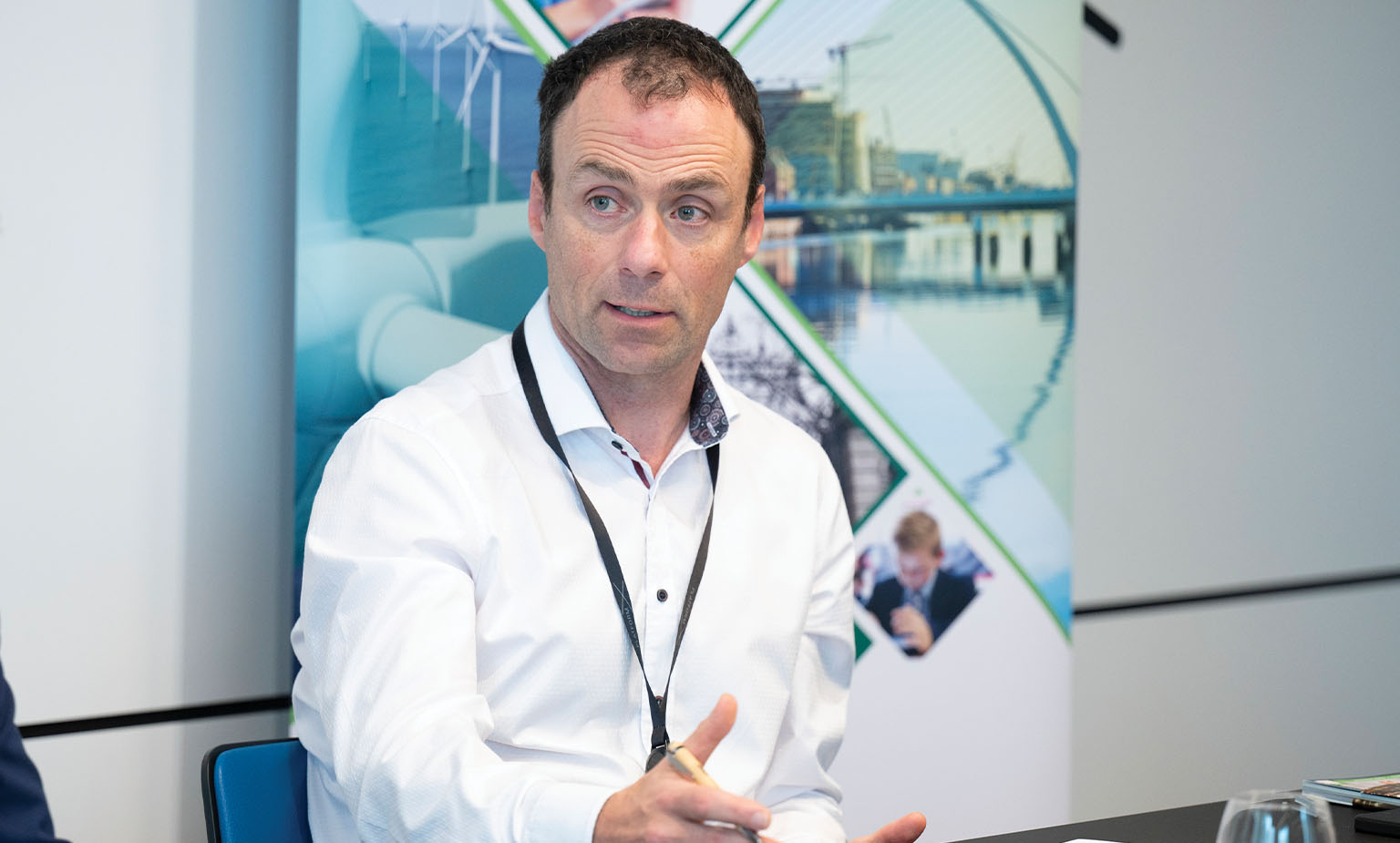
“Policy is ultimately what will drive a sustainable infrastructure system.”
Henry Bouchier
Henry Bouchier
Project delivery models are often solely focused on the delivery of a project. Another way of looking at innovation is that it is driven by necessity. There was a problem that had to be solved. Learnings captured during a project can be carried into others and disseminating these across the industry is important. Likewise, early contractor involvement and understanding your supply chain are important. For instance, I can pursue an innovation for building a substation, but this can be enhanced through engagement with project partners. It is important to ensure timely engagement with the supply chain. Much of the IP around projects and innovation is siloed in individual organisations. We must unlock this to our mutual advantage.
Paul Tierney
People talk about the lack of an infrastructure pipeline when, in reality, a huge pipeline exists across housing, healthcare, and education. The challenge is that the existing pipeline is neither sustainable nor buildable from an industry perspective. This is a major barrier to investment. Engaging industry to establish a buildable pipeline will open the market to significant investment. Simultaneously, there is a general absence of standardisation – though I know that the LDA and DHLGH and Daniel’s team at Construct Innovate are working on standardisation in housing. This absence is a massive barrier to investment from the perspective of contractors and manufacturers.
How can the infrastructure market be incentivised to invest in and accelerate innovation in sustainable delivery?
Michael Goan
Over the last 18 to 24 months, there has been an exponential change in attitudes towards sustainability and the built environment as EU directives and legislation have impacted flows of finance. This includes the EU Taxonomy Regulation for sustainable activities and the Corporate Sustainability Reporting Directive (CSRD) which impacts all the commercial semi-state companies. We have moved from sustainability reporting to a disclosures-based system, whereby we are required to measure the same metrics and report in the same ways to enable comparability between companies. That is a huge incentive for companies. The incentive has shifted as much towards the corporate responsibility and reputational risk management as it has towards commercial drivers. On the demand side, customers are asking for sustainability, as are boards and shareholders on the commercial side.
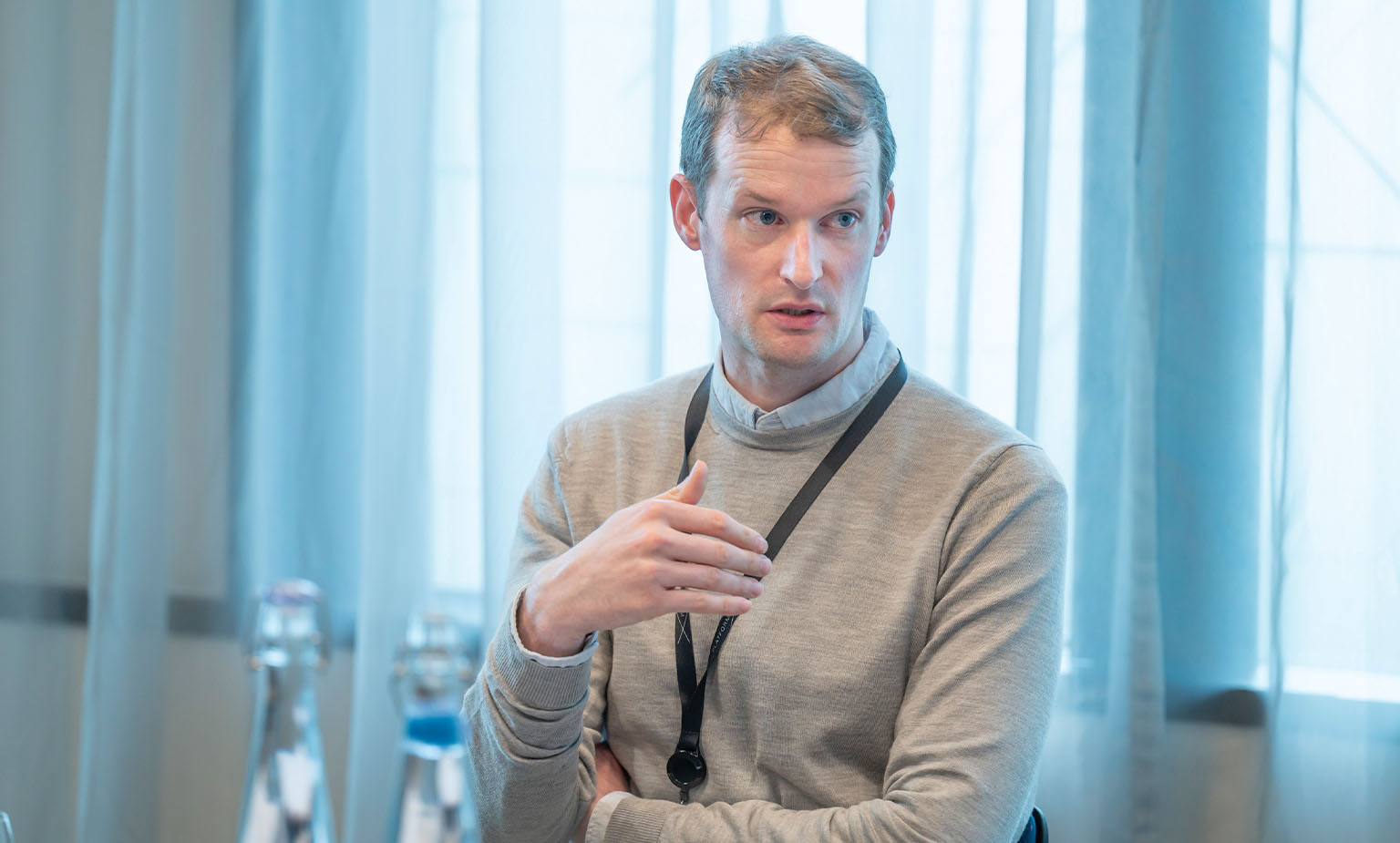
“One challenge we face is relatively low productivity in the construction sector.”
Daniel McCrum
Daniel McCrum
As Enterprise Ireland often demonstrates, companies which undertake innovation earn more money. So, why are they not all doing it? Speaking with those companies which do not undertake innovation suggests that, for many, derisking innovation is hugely important. Construct Innovate is working to achieve this. In relation to infrastructure specifically, I would love to see the Sustainable Energy Authority of Ireland or Science Foundation Ireland issue funding calls for the infrastructure industry. Industry must inform these funding bodies exactly what it is they require, so they can drive the need. Access to facilities and expertise – including via Construct Innovate – is important. The expertise exists, but we must establish effective networks between people. We need significant investment in our facilities for product development and certification. Industry needs to contribute to this.
Paul O’Neill
As evidenced by the fact only two or three international contractors have a presence in the State, the infrastructure market does not believe that there is a clear pipeline of opportunities. The NDP is ambitious, but we must demonstrate what opportunities exist. Otherwise, rather than wasting time on tendering, key market players will simply opt to work elsewhere.
Paul Tierney
Why do companies not undertake innovation? There is consensus that engaging with Enterprise Ireland is too onerous and the time and effort required for grant aid applications outweighs any benefit. Alternatively, engagement with Construct Innovate is a much more streamlined process that unlocks exponential benefit.
Henry Bouchier
Who benefits from innovation? Ultimately, while the companies that develop the infrastructure do benefit sustainable infrastructure development will have a positive impact for wider society. Therefore, we must create the conditions whereby innovation can happen, for example through incentivisation in the procurement process, In doing so, it is possible to cultivate innovation in sustainable infrastructure delivery.
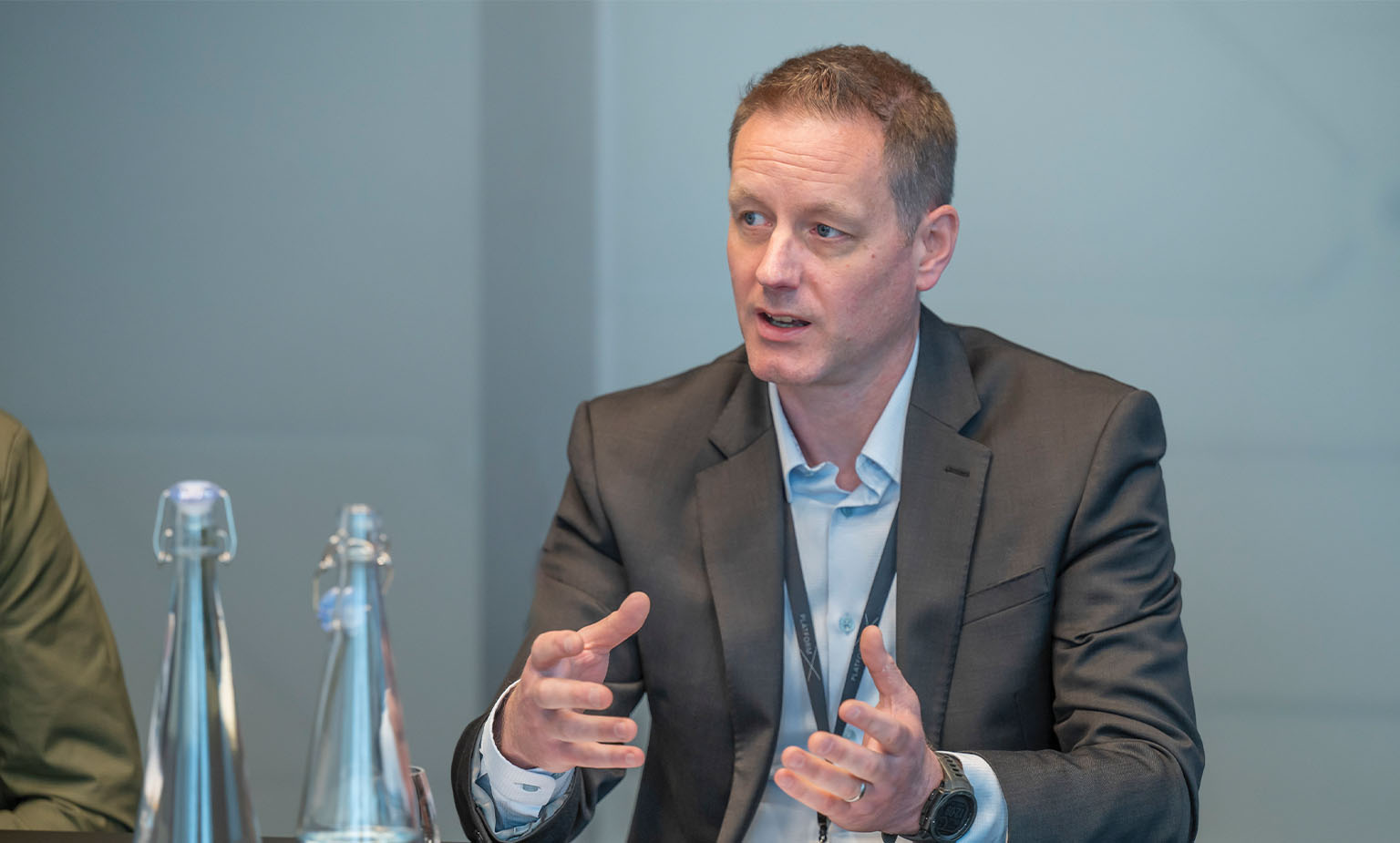
“Given our dependence on this supply chain for sustainable infrastructure delivery, we need a commitment to long-term funding…”
Mark Macaulay
Mark Macaulay
Uisce Éireann has observed the confidence that is unlocked by having a sustainable multiannual pipeline. This requires a signal to be sent to the market that there is a long-term opportunity and profit margins will be made. In private sector markets, shareholders are relying on companies’ sustainability credentials. For large infrastructure projects, there must be a national realisation of the cost of achieving our sustainability targets. We are engaging with utilities and representative bodies across Europe to develop viable options and solutions. Understanding the factors behind a strong pipeline is key to creating market commitment.
How can collaboration help navigate regulatory requirements and compliance challenges in sustainable infrastructure development?
Paul Tierney
The biggest collaborative project I have experienced was the delivery of homes for Ukrainian refugees in 2023 and 2024. All stakeholders collaborated throughout the process of delivery. Under the leadership of the Office of Public Works (OPW), which was the government agency managing the project, Sisk Group managed the contracting side alongside five manufacturers and a design team. The stakeholders were happy to collaborate because there was a standardised pipeline for at least 12 months they and were confident in committing resources for delivery. I believe this is a blueprint as to how we can deliver going forward.
Mark Macaulay
The main contributing factor in the success of delivering homes for Ukrainian refugees was a single focus. All stakeholders knew the problem they were there to solve. In the absence of a single vision, there is a tendency for different stakeholders to retreat into their own siloes. Uisce Éireann has its own targets which, for natural reasons, are related to water and wastewater. However, if there is a compelling vision for us all to work towards, then the opportunities for collaboration will multiply. 92 per cent of companies have six or less full-time staff, so if the large companies can lead and create the knowledge, the smaller ones will follow and bring about the kind of progress we need.
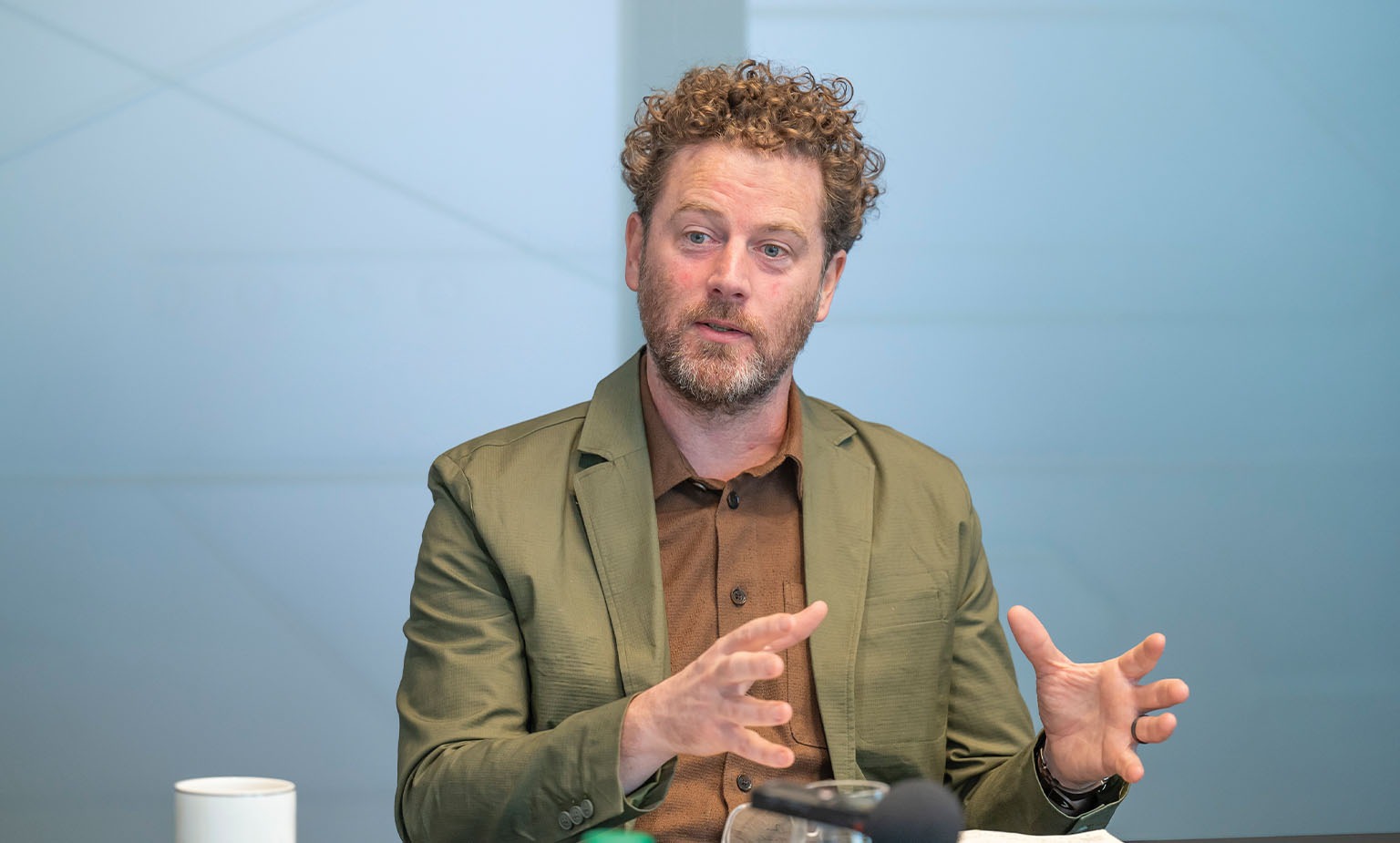
“Over the last 18 to 24 months, there has been an exponential change in attitudes towards sustainability and the built environment…”
Michael Goan
Michael Goan
On the wider concept of infrastructure, we must remember that this includes social infrastructure. When we go into communities, we have a red line delineating the site, but there is also a catchment area surrounding it in which people live and have lived, often for several generations. What we need to remember is the importance of engaging with these communities and bringing them along the journey. Social sustainability relies on buy-in from the communities within which you are working.
Daniel McCrum
We need to appreciate that the construction industry – given its experience – is very conservative. Government leadership has been strong through recent change and the key departments have made themselves available to industry leaders. In Construct Innovate, we have seen that the sharing of resources is taking place with multiple companies buying into single research projects, because industry leaders can see the value in collaboration. Also critical is that we are openly publishing the findings upon the completion of these research projects so that wider learning is achieved.
Henry Bouchier
While previously the sector has been slow at times to do this, we must ensure that we bring stakeholders on board particularly those at community level. I thought the recent oral hearing process for the MetroLink project was well handled in that An Bord Pleanála gave stakeholders the chance to be heard including at local community level.
Paul O’Neill
With the NDP, the various policy initiatives which have taken place in recent years, the frameworks are there for progress to take place and this will outlast any government cycle. The Irish market is flexible, and we have the skillset and ambition to deliver. We must back ourselves and facilitate the space for innovation.





